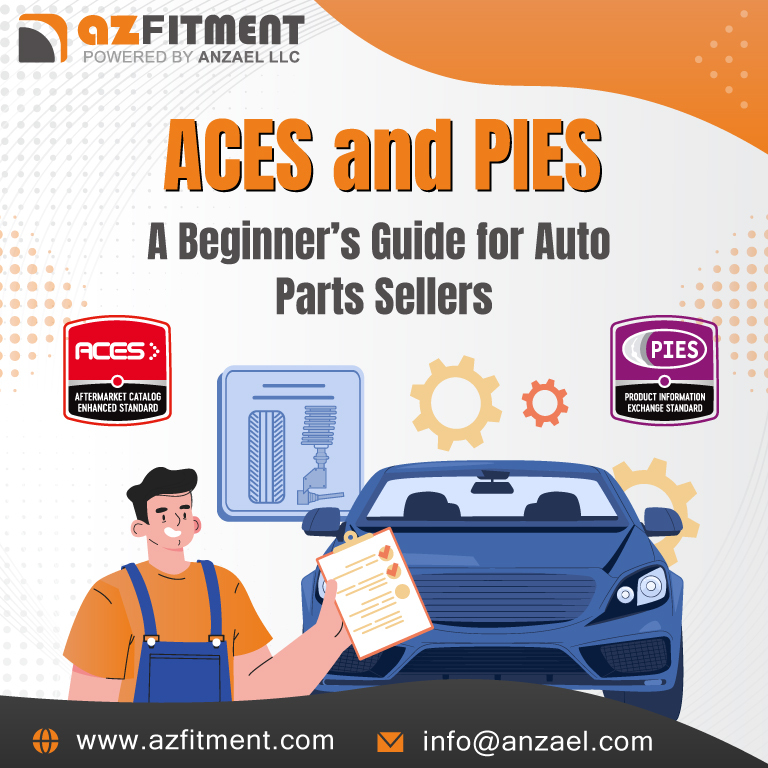For auto parts sellers looking to get a foothold in marketplace sales across the USA and Canada, understanding ACES & PIES is more than just a technical requirement—it’s a gateway to success. These data standards streamline how automotive information flows between sellers, manufacturers, and marketplaces, helping you list products accurately and connect with your target customers efficiently.
If you’re new to these terms or find them a bit overwhelming, this guide walks you through the basics. By the end, you’ll have a clearer picture of what ACES & PIES standards are and why they’re invaluable for your business.
What Are ACES & PIES?
ACES (Aftermarket Catalog Exchange Standard) and PIES (Product Information Exchange Standard) are the two primary data formats used in the automotive aftermarket industry. These standards were developed to create uniformity in how product and vehicle information is structured and shared in the US market.
ACES (Aftermarket Catalog Exchange Standard)
- Purpose: ACES is focused on vehicle fitment data. It allows sellers to link specific products to compatible vehicles.
- How it works: The data is organized into the ACES vehicles database, which contains information like make, model, year, and engine type.
- Why it matters: Without ACES, it can be incredibly difficult to ensure that your products are listed correctly for specific vehicles, leading to frustrated customers and lost sales.
PIES (Product Information Exchange Standard)
- Purpose: PIES handles product information like part numbers, dimensions, pricing, and availability.
- How it works: Sellers use the PIES model to convey standardized product descriptions alongside associated assets like images or videos.
- Why it matters: Accurate and consistent product information ensures your listings meet marketplace requirements and look professional to your buyers.
By combining ACES and PIES, you establish a robust system where your products are not only correctly listed but also more likely to reach the right audience.
Why Are ACES & PIES Crucial for Auto Parts Sellers?
The automotive aftermarket is vast and competitive. Here’s why adopting these standards is critical for your business:
- Accuracy in Listings: Proper vehicle fitment improves customer satisfaction by ensuring they buy the right parts.
- Compliance with Marketplaces: Leading platforms like eBay Motors, Amazon, and Walmart demand data formatted in ACES and PIES.
- Efficiency in Updates: Using automotive aftermarket software to manage your ACES & PIES data eliminates manual errors and speeds up your listing process.
- Better Search Visibility: Well-structured product and fitment data help algorithms rank your products higher in search results.
- Streamlined Communication: Whether you’re working with manufacturers or distributors, adhering to these standards allows for seamless data exchange.
How to Get Started with ACES & PIES?
If you’re ready to implement these standards, here’s a simplified guide to help you begin:
1. Understand Your Products and Vehicles
Start by identifying which of your products need fitment data. Compile a list of vehicle makes and models that your products match.
2. Choose the Right Tools
Invest in automotive aftermarket software that simplifies the creation, storage, and export of ACES & PIES data. Examples include middleware platforms that integrate directly with online marketplaces.
3. Standardize Your Data
Organize your information in accordance with ACES & PIES standards. Focus on accuracy when inputting details like vehicle fitment, dimensions, and images.
4. Partner with Data Providers
If creating data from scratch seems daunting, consider working with a data management service provider familiar with the ACES vehicles database and PIES format.
5. Test and Monitor
Before sending your product data live, test it for consistency. Once live, monitor listings for any errors or customer feedback that indicates issues with product compatibility.
Benefits of Using Automotive Aftermarket Software
Automotive aftermarket software plays a pivotal role in managing ACES & PIES data efficiently. Here’s how it helps:
- Automated Updates: Tools can automatically pull updates from sources like the ACES vehicles database to keep your fitment data current.
- Reports and Insights: Get analytics on which products perform the best and which listings require improvement.
- Time Savings: Spend less time on manual data input and more on growing your business.
By integrating technology into your workflow, you pave the way for long-term scalability and customer satisfaction.
ACES & PIES in Action
Still unsure how these standards help in the real world? Here’s a quick example:
Imagine you’re selling a set of brake pads designed for specific Ford and Chevrolet models. With an ACES-compliant dataset, you can list the precise makes and models these brake pads fit—say, Ford F-150 (2018-2022) and Chevrolet Silverado (2020-2023). PIES, on the other hand, will help you include detailed product specs, pricing, and high-resolution images, ensuring buyers have all the information they need to purchase confidently.
Without these structured data formats, you risk confusing buyers, leading to lower sales and higher return rates.
Final Thoughts
For auto parts manufacturers and sellers, ACES/PIES are no longer optional—they’re essential. These data standards allow you to list your products accurately, satisfy your customers, and comply with marketplace requirements.
By adopting tools and practices that support the ACES format and PIES model, you’re not just streamlining your operations; you’re setting your business up for long-term success. If you haven’t implemented these systems yet, now’s the perfect time to start.
Pro Tip: To simplify the process of managing ACES & PIES data, consider working with industry professionals or software solutions designed specifically for auto parts sellers. They’ll save you both time and headaches as you scale your online business.
Take the first step toward organized, error-free listings today!


